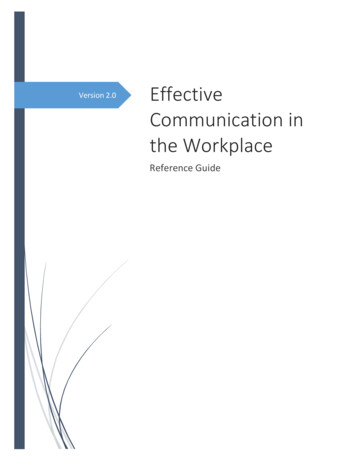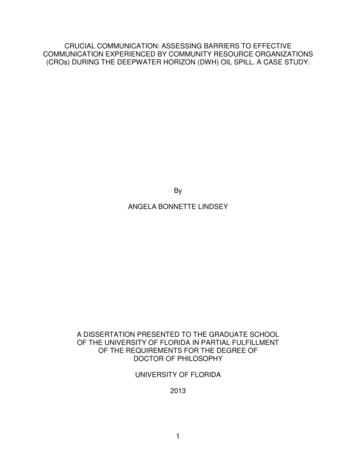
Transcription
Effective Communicationi
Effective CommunicationAbout the TutorialCommunication is the lifeline of society and business organizations. An organization canhardly be conceived without communication. In the absence of one of the most essentialgradients like communication, an organization would turn into a mere assembly ofunrelated and unorganized individuals, materials and machines and tools, which neithermakes any sense nor, in fact, any kind of organization.Prevalence of unperturbed and meaningful communication system, which is calledEffective Communication, is therefore sine qua non for the sustenance and growth of anorganization. In this context, the study of communication in management education andoperation of an organization has been quite unavoidable. Regular training and refreshmentis always provided to people in an organization to maintain Effective Communication.The present Tutorial ‘Effective Communication’ is a concise, meaningful and intelligibleapproach to get acquainted with some of the significant and relevant aspects of EffectiveCommunication. Presented with facts and figures and devoid of lengthy descriptions, theTutorial is easy to read and understand.AudienceThis Tutorial caters to the needs of both the students of management and organizationalpeople. It will serve them as a reliable guide and enable them to know how to communicateeffectively.PrerequisitesThe readers of this Tutorial should have basic knowledge about the management conceptsand principles. It is also essential to know how communication is a necessary gradient insociety and international relations. In our day to day life, how a simple gesturecommunicates a meaningful message and how bad communication affects interpersonalrelationship in the society.Copyright & Disclaimer Copyright 2016 by Tutorials Point (I) Pvt. Ltd.All the content and graphics published in this e-book are the property of Tutorials Point (I)Pvt. Ltd. The user of this e-book is prohibited to reuse, retain, copy, distribute or republishany contents or a part of contents of this e-book in any manner without written consentof the publisher.We strive to update the contents of our website and tutorials as timely and as precisely aspossible, however, the contents may contain inaccuracies or errors. Tutorials Point (I) Pvt.Ltd. provides no guarantee regarding the accuracy, timeliness or completeness of ourwebsite or its contents including this tutorial. If you discover any errors on our website orin this tutorial, please notify us at contact@tutorialspoint.comi
Effective CommunicationTable of ContentsAbout the Tutorial . iAudience . iPrerequisites . iCopyright & Disclaimer . iTable of Contents . ii1.Communication – Introduction . 1What is Communication? . 1The Process of Communication . 3Definitions of Communication . 3Importance of Communication in Society . 3Importance of Communication in Business . 4Interpersonal Skills . 42.Communication – The Different Styles . 63.Effective Communication – Meaning and Definition . 10Significance of Effective Communication . 11Characteristics of Effective Communication . 12Effective Business Communication . 13Effective Oral Business Communication . 13Effective Written Business Communication . 15Types of Communication . 16Types of Informal Communication . 19Downward and Upward Communication . 204.Effective Communication – Process . 23The Different Elements in The Process of Communication . 23The Model of Communication Process. 265.Effective Communication – Models. 28ii
Effective CommunicationComponents of Interactive Model . 31Effectiveness of Communication Models . 326.Effective Communication – Barriers . 33What are Barriers? . 33Dealing With Barriers to Effective Communication . 37How to deal with barriers in non-verbal communication . 38How to Deal with Barriers in Verbal Communication . 39Barriers to Effective Listening . 39Linguistic/Semantic Barriers . 40Socio-Cultural Barriers . 40Psychological Barriers . 41Physical Barriers . 41How to deal with Barriers in Written Communication . 42Consequences of Poor Communication . 447.Effective Communication – Employment Communication . 47Curriculum Vitae Resume & Biodata . 48Components of a Good CV . 48How Does A Resume Work? . 50How Does A Biodata Work? . 51Do’s And Don’ts in Preparing CV or Resume . 52What Is a Job Application Letter? . 53Job Interview . 54Thank You Note . 57What are . 59Etiquettes? . 59Common Business Etiquettes . 60iii
1. Communication – IntroductionEffective CommunicationCommunication is as old as human civilization. Man used to communicate with his fellowbeings by means of sounds, signals, gestures when there was no language developed.Minus communication, human society could not have been as it is today. It iscommunication which has transformed mankind into the most developed rational andprosperous group on the earth.What is Communication?Communication is the activity of conveying information. The word communication has beenderived from the Latin word ‘communis’, meaning to share. It basically involves a sender,a message and a receiver.1
Effective CommunicationCommunication is giving, receiving or exchanging ideas, data, information, signals ormessages through appropriate media, enabling individuals or groups to persuade, to seekinformation, to give information or to express emotions.Communication is usually a two-way process. It is not just giving information or signalingsomeone; it also involves the comprehension of the information or the signal by thereceiver. When the act of giving information or sending message reaches the recipient andgets comprehended by him/her and the receiver sends feedback as desired by the sender,the process of communication is said to be complete. Communication, therefore, involvesmore than one person.Communication is a continuous and dynamic process involving more than one person. Itis a cyclic process denoting continuous flow of information. It essentially involves sender,message and recipient. The sender conceives ideas and encodes them into suitablemedium (facts, figures, pictures), sends them through appropriate channel (email, phone,speech) to the recipient. The recipient decodes the message, understands it and encodesfeedback and sends it to the sender. The process NTPROPERCHANNEL2
Effective CommunicationThe Process of CommunicationCommunications refers to a set of techniques used for expressing ideas effectively and thetechnology of transmission of information by print or telecommunication media.Communication is lexically meant to be the imparting or exchanging of information byspeaking, writing or using some other medium.It is the act of conveying intended meaning from one entity or group to another throughthe use of mutually understood signs or semiotic rules.Definitions of CommunicationCommunication is defined by different authors as follows.Ordway Tead“Communication is a composite of (a) information given and received, (b) of a learningexperience in which certain attitudes, knowledge and skills change, carrying with themalternations of behaviour, (c) of a listening effort by all involved, (d) of a sympathetic freshexamination of issues by communicator himself, (e) of a sensitive interaction of points ofview leading to a higher level of shared understanding and common intention.”G.G. Brown.“Communication is transfer of information from one person to another, whether or not itelicits confidence. But the information transferred must be understandable to thereceiver.”Louis A. Allen“Communication is the sum of all the things one person does when he wants to createunderstanding in the mind of another. It is a bridge of meaning. It involves a systematicand continuous process of telling, listening and understanding.”Fred G. Meyer“Communication is the intercourse by words, letters or messages”.Keith Davis“Communication is the process of passing information and understanding from one personto another.”Importance of Communication in SocietyIt is communication that binds people and society together. It is considered as a naturalprocess.Society moves on human interactions and exchange of ideas, thoughts, and feelings.Relationship builds up through communication.Lack of communication among the people in society will severely affect social cohesionand cohabitation. Progress and prosperity will come to a standstill if there is no effective3
Effective Communicationcommunication. Communication is a factor of building and maintaining good relations. Itenables people to understand each other.Communication is as important and meaningful in individual life as in the society.Individuals make friends, builds up relationship and lead a true social life throughcommunicating effectively with the fellow beings.Importance of Communication in BusinessCommunication is the lifeline of a business organization. It is essential for realizing theobjectives of an organization.According to Millet, “Communication is blood stream of an organization”.Chester I. Barnard viewed communication as the means by which people are linkedtogether in an organization to achieve a common purpose.The importance of communication can be assessed as follows: Communication is needed to establish and disseminate the goals of a businessorganization. The smooth and unperturbed functioning of an enterprise. Communication helps the organization in arriving at vital decisions. It also helps a lot in planning and coordination. It is a basic tool for motivation and an increase in the morale of the employeeslargely depend upon the effectiveness of communication. It helps a business as means of bringing about maximum production at the lowestlevel by maintaining good human relationship in the organization. It works as an effective link between branches of the organization situated at greatdistances. It helps in publicizing goods and services. It reduces rumors and ensures smooth running of the organization as a whole.Interpersonal SkillsInterpersonal skills refer to the ability to communicate or interact well with other people.In business lexicon, it means the set of abilities enabling a person to interact positivelyand work effectively with others.It is the process by which people exchange information, feelings, and meaning throughverbal and non-verbal messages: it is face-to-face communication.In the absence of effective interpersonal communication among employees themselves,between the management and the employees, a business organization fails to ensure itssmooth functioning and gradually runs away from realizing its objectives.Interpersonal communication skills are necessary prerequisites for enhancing productivityand continuity of the workforce within an organization. Employees with good interpersonalskills are likely to be more productive and permanent than those with poor interpersonal4
Effective Communicationskills because the former displays propensity to project a positive attitude and look forsolutions to problems.Components of Interpersonal SkillsThe following are the different components of interpersonal skills:Sender Communication is always complex two way processinvolving sender and receiver. The sender transmits a message to another person.Message Message is the element that is tranmitted from oneperson to another. Involves both verbal (speech and information) andnon-verbal messages (gestures, body languages)Self - concept A person's attitude and views affect teh way he shecommunicates with others.Listening Lilstening integrating physical, emotional andintellectual processes and is much more complicatedthan hearing.Receiver The receiver receives the message and decodes themessage and assign a particular meaning to it.Feedback The receiver communicates back to the sender his/herunderstanding of the message. Feedback is a two-way interaction.Barriers Anything that comes in the way of communicationexchange.Interpersonal communication is not just about what is actually said - the language used but how it is said and the non-verbal messages sent through tone of voice, facialexpressions, gestures and body language.Summary Communication is the activity of conveying information. Communication is usually a two-way process. It is not just giving information orsignaling someone; it also involves the comprehension of the information or thesignal by the receiver. Society moves on human interactions and exchange of ideas, thoughts, andfeelings. Relationship builds up through communication. According to Millet, “Communication is blood stream of an organization”.5
2. Communication – The Different StylesEffective CommunicationCommunication style refers to the way in which the act of communicating is carried on.Styles of communication may differ from occasion to occasion. Each style serves a differentpurpose.The knowledge of communication style is required in order to understand which one bestsuits or which one to use on different occasions. It is also required to know the effect ofeach communication style on normal social interactions and of course, on businessconversations and interactions.Whatever style a communicator uses, he/she should solely aim at having an effectivecommunication.There are four major styles of communication which are discussed below.Aggressive Communication StyleLet us now see what this aggressive communication style is all about: In Aggressive style of communication, one always stands up for one’s rightssimultaneously overlooking others. Sometimes doing so may result in the violationof the other’s rights. Aggressive communication style is presented rather in a forceful and hostilemanner and always involves the ‘I’ syndrome (I am right; my points are morevaluable than yours; I am superior, etc.) and is always based on wrong premisesthat ‘you are not important; your needs don’t matter’. It alienates messages byblaming others and accusing them of being wrong or at fault. Such communicatorsgive the impression of being superior in attitude, domineering and self-important. They may have a loud voice and articulate mostly in the second person. Their non-verbal cues are narrow eyes, clenched fists, pointing fingers, rigidposture and hard stares.6
Effective Communication These types of communicators often face disrespect from others. They are theworst victims of low self-esteem. As a consequence, they easily incur other people’swrath and in the worst case people avoid them out of fear. They give an impression that they have something to contribute and others havelittle or nothing to contribute. The aim of aggressive behavior is to win at any cost.Passive Communication StyleLet us now see what this passive communication style is all about: Passive communication style stands in contrast to aggressive style in meaning anduses. The passive style of communication allows the communicator to put others’ rightsbefore his and thus reduce his own self-worth. Passive communicators always consider themselves to be inferior to others. Theynegate their personal feelings, rendering themselves unimportant. They fail to express their needs, wants, feelings, opinions and beliefs and expressthem in an apologetic and self-effecting manner. They have an overly soft voicewith an apologetic demeanor. They create a negative impression on others by their non-verbal signals. They shyaway from maintaining eye contact with people. Their downcast eyes, stooping posture and excessive nodding of the heads mayindicate lack of drive and motivation. They suffer from poor self-esteem and are heavily dependent on others for supportand recognition. They are easily victimized and exploited at the same time, as otherpeople tend to disrespect them. The aim of passive behavior is to avoid conflict and to please others.Manipulative Communication StyleLet us now see what this manipulative communication style is all about: People adopting the manipulative communication style are often scheming, shrewdand calculating. They are at adept at influencing and controlling others for their own benefits. They have a hidden message when they speak and many times other persons areunaware of their hidden intention. They act cunningly and tactfully and influence people in an insidious way such assulking, shedding fake tears, indirectly asking for their needs to be met. Theysometimes become successful in making people feel sorry or obliged to help them. However, their hidden motives are exposed. They are shunned and ridiculed byother people.7
Effective CommunicationAssertive Communication StyleLet us now see what this assertive communication style is all about: Assertive communication style is regarded as the best communicating style. It ismore rational and proper than other styles of communication. This style teaches one to stand up for one’s rights while having respect for othersrights. Those communicating with assertive communicating style give importance andregard to others as well as to their own rights. They deal with people on equal terms. They exude confidence in whatever they do and always own up responsibility fortheir actions. Assertive communicators stand firmly on their foot and don’t buckleunder pressure. Talking straight on the face, looking directly, always at ease with oneself andothers, relaxed and smooth body movements are some of the strong characteristicsof any assertive communicator. Assertive communicators always buzz with life and activity wherever they go. These people are positive with a high self-esteem. As they give respect to all andthey also get the same back in abundance. The aim of assertive behavior is to satisfy the needs and wants of any two partiesin a given situation.Amongst these three distinctive styles of communication, the Assertive style ofcommunication is the one to strive for. Depending on your personal circumstances, youcan make use of the other two styles as well. In a situation, where being passive maydrive home an important point or may resolve an issue it is better to act passive. Likewise,aggressiveness also helps sometimes in turning a situation in your favor, especially whenyou know you are not getting anywhere in that situation.Case StudyMr. Roy is a sincere and hardworking person who does his job quietly and does not like toargue much. He prefers to write notes and send written messages instead of face-to-faceinteraction. He is being given the responsibility of leading a team to handle a prestigiousproject. But before that he has to get the project approved by the board of directors. Canyou suggest what style of communication he should use to make it a success? Discusswith your instructor.SummaryCommunication style refers to the way in which the act of communicating is carried on. There are three major styles of communication:oAggressive Communication StyleoPassive Communication StyleoManipulative Communication Style8
Effective CommunicationoAssertive Communication Style Aggressive communication style is presented rather in a forceful and hostilemanner and always involves the ‘I’ syndrome The passive style of communication allows the communicator to put others’ rightsbefore his and thus reduce his own self-worth. People adopting the manipulative communication style are often scheming, shrewdand calculating. Assertive communication style is regarded as the best communicating style. It ismore rational and proper than other styles of communication.9
3. Effective Communication – Meaning andDefinitionEffective CommunicationCommunication as we have read in this Tutorial is sine qua non in a business organization.However, unintelligible and entangled communication fails to achieve the desired resultand affect work environment in an organization.In a layman’s lexicon, communication is understood to be day-to-day talks and discussionswe all engage with. Though the broader meaning of communication covers all humaninteractions, in management parlance, communication is not mere talking, chattering orblabbering in a nonsensical manner. Communication is not as simple as it appears. It issystematic process with an objective that a piece of communication aims to achieve. Itcan be defined as a process of translating any thought process into simple and meaningfulutterances through an appropriate channel.Communication needs to be effective and efficient for better and smooth functioning of anorganization.Effective communication is defined as communication between two or more persons inwhich the intended message is: properly encoded delivered through appropriate channel received properly decoded and understood by the recipient(s)In other words, communication is said to be effective when all the parties (sender andreceiver) in the communication, assign similar meanings to the message and listencarefully to what all have been said and make the sender feel heard and understood.In a business organization, communication is said to be effective when the information ordata shared among the employees effectively contribute towards organization’scommercial success.In the words of R.W. Griffin, "Effective communication is the process of sending a messagein such a way that the message received is as close in meaning as possible to the messageintended".American Management Association (AMA) has defined effective communication based onthe following ten points: Clear idea regarding topics and receiver of communication. Determination of purpose. Understanding the environment of communication. Planning for communication with consulting others. Consider the content of the message. To make the receiver aware about the value of communication. There must be feedback from the receiver.10
Effective Communication To define properly whether communication messages are of short-run or long-runimportance. All actions must be suitable with communication. Good listening.Effective Communication is defined as the ability to convey information to anothereffectively and efficiently. Business managers with good verbal, nonverbal and writtencommunication skills help facilitate the sharing of information between people within acompany for its commercial benefit.Significance of Effective CommunicationIn this section, we will understand the significance of effective communication:Construct and Foster Sustainable and Productive RelationshipEffective communication should be the focus in businesses as it becomes largely difficultto properly construct and foster productive relationship without it.Give space to InnovationsEffective communication facilitates innovations in a business organization by allowingemployees and management to come up with innovative ideas that might further help inthe overall development of the organization.Help Build an Effective TeamA work environment enriched with effective or open communication helps in building acohesive and effective team. Effective communication always boosts the morale ofemployees. It brings in the zeal in employees to work towards achieving the commonobjectives of the organization. Regular internal communication can also lead to animproved work ethic if the staff are reminded of achievements and feel that they areworking towards a common goal.Effective ManagementWhen there is hassle-free and open communication between the management and theemployees, it leads to a steady rise in the pace of progress of the organization. Effectivecommunication, therefore, yields effective management. Managers come to know theattitude and grievances of the employees and the latter gets to know the managers’attitudes towards them and also the policies of the organization.Contributes to the Overall Growth of the OrganizationEffective communication builds desired interpersonal, interdepartmental andmanagement-employee relationship which in turn are essential preconditions for realizingthe vision of the organization. In other words, effective communication contributes to theoverall growth of the business.At the professional level, it is essential to know how to deal adequately with peers, makegood decisions
Communication is defined by different authors as follows. Ordway Tead “Communication is a composite of (a) information given and received, (b) of a learning experience in which certain attitudes, knowledge and skills change, carrying with them alternations of behaviour, (c) of a lis











